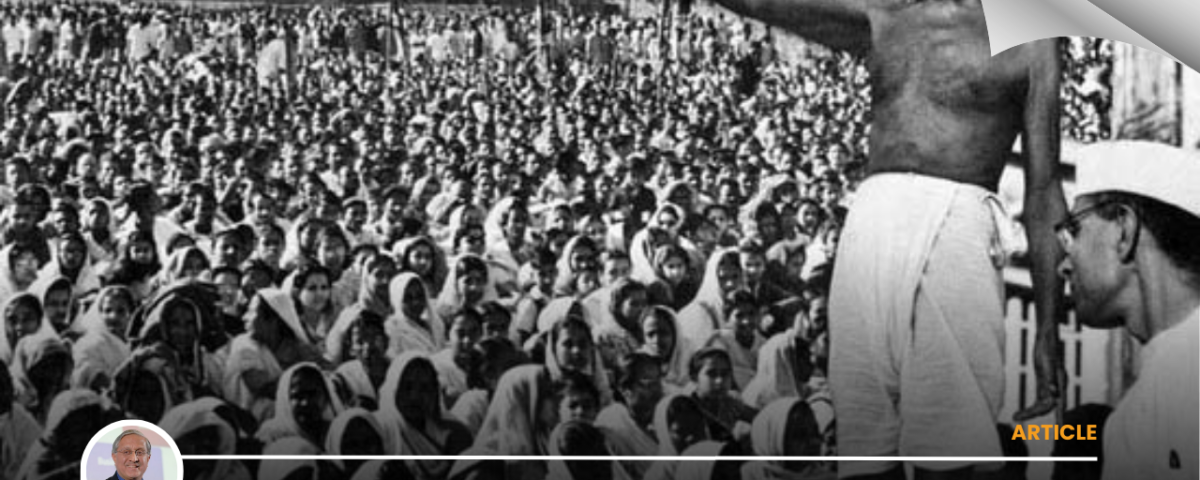2nd October 2016, ECONOMIC TIMES
On Gandhi’s birth anniversary and as the government designs its global communications after the horrific Uri incident, I am tempted to recall Gandhi’s response in the face of great provocation. In many ways, Gandhi was a journalist first, and a politician later. He ran and published weeklies which made no profit, but also made no loss. He was responsible for as many as six journals over nearly forty years. Gandhi wrote in a blunt and direct manner with no consideration for what criticism his writing may attract. The simplicity and clarity of Gandhi’s messages are exemplary as evidenced by the following extractsfrom Young Indian :
- “The curse of foreign domination and the attendant exploitation is the just retribution meted out by God to us for our exploitation of a sixth of our race and their studied degradation in the name of religion.” (YI, 29-12-20)
- “Hinduism has sinned in giving sanction to untouchability.” (YI, 24-2-21)
- “We glibly charge Englishmen with insolence and haughtiness. Before we cast a stone at them, let us free ourselves from liability to reproach.” (YI, 11-5-21)
The Transvaal Ordinance, 1906
The Asiatic Ordinance of August, 1906 by the Transvaal government required every Indian resident in Transvaal to register afresh, regardless of gender or age. The certificate was to be carried at all times by the person or else there was the threat of arrest, imprisonment or expulsion. This requirement was hugely offensive to the Indians in South Africa. How did the community respond?
- The protestors were made aware of who designed this offensive requirement and why it was done. Lionel Curtis was the Assistant Colonial Secretary of Transvaal and his views on race were not quite the best kept secret in the region. His purpose in issuing the ordinance was simple and clear: to shut the gate against an influx of Asian population.
- Gandhi’s Indian Opinion denounced the ordinance as ‘abominable….it threatened to invade the sanctity of home life…..drafted with the deliberate intention of injuring the Indian community.” This was a clear and unequivocal communication of the deep offence within the Indian community. But clearly such denouncement by itself would not suffice.
- Gandhi then led a delegation to meet Patrick Duncan, Colonial Secretary, in Pretoria. Not unexpectedly, Mr Duncan refused to withdraw the ordinance. Indian Opinion then compared the Czarist regime in Russia, which ‘murders people openly and directly’ with the British Rule in Transvaal, which ‘kills the people by inches.’
- The Indian community from every nook and corner of Transvaal assembled at the Empire Theatre in Johannesburg. It was 1.30 pm in the afternoon on a Sunday. “There were 3,000 angry delegates, many of whom were urging violent resistance to the ordinance,” according to writer Fatima Meer. “He (Gandhi) took the platform and he began to speak. He cast a slow, quiet spell, and as he did so, bound Hindus, Muslims and Christians as one within its web.” Gandhi recounted that the concept of Satyagraha came to him like a bolt from the blue during this historic meeting.
- Since there was a need to lobby in London, Gandhi travelled to Cape Town and London. He sought Lord Elgin, Secretary of State for Colonies, seeking an appointment. Since Elgin had served in India as Viceroy, there was hope that the delegation would be heard carefully. Indeed the delegation was heard well enough for Gandhi to describe the meeting as ‘exceedingly good.’
- Despite Gandhi’s communications strategy, which progressively upped the ante, the Boers and Britons of Transvaal were determined to deny the elementary rights of citizenship to the coloured people.
Whatever the outcome of the Transvaal Bill, Gandhi’s communication and resistance strategy was shaped through his experiences from the opposition to the Transvaal Bill.
Shaping the movement
Intellectual and writer Nikhil Chakravartty (called NC), delivered the Gandhi Peace Foundation Lecture by comparing the Indian Freedom Struggle under Gandhi’s leadership with revolutions in history.
The French revolution in the eighteenth century was born out of the mass discontent prevailing at that time. It was led by a small band of determined revolutionaries, perhaps a few thousand people, mostly in Paris. Once the fuse was lit, the agitation spread all over France in a spontaneous upsurge. However the revolution ‘devoured its own children’ because the leadership at the core could not hold its own, nor was there any continuity in the leadership. People who led it in the beginning were soon left by the wayside or liquidated.
The Russian Revolution too was led by a small band of people, but it developed in quite a different way. It had a more organised leadership compared to the French revolution. The First World War showed up cracks in the decadent Czarist imperial system. This provided the opportunity for a determined band of communist militants, led by Lenin, to capture power ruthlessly. The Bolsheviks first captured the key points of power, and then set out to redesign the social and economic system according to what they thought was appropriate.
The Chinese Revolution in the twentieth century bore some similarities to the Russian Revolution insofar as it also had a broad sweep and was led by a communist party. Just a few thousand revolutionaries under Mao Zedong undertook the Long March, a decade-long armed sojourn through rural China, to arouse and harness the anger of the peasantry against the deposed Qing dynasty and the ineffective Kuomintang successors.
Gandhi had the challenge of mobilising large numbers of docile Indians into a sustained movement. Communicating with millions of illiterate and geographically spread-out Indians, doing so sufficiently effectively to motivate them to rise from their inertia and harnessing their energy were all hugely challenging—all this without the modern tools of internet, public relations, advertising and so on.
A remarkable feature of Gandhi’s messaging and appeal was that he reached out to all: poor and rich, urban and rural, north and south. Attracting common people in the millions into a movement for independence without resorting to arms and violence, which are usual characteristics of other revolutions, is a great testimony to his communication and motivating skills.
The Salt March in 1930 from Ahmedabad to Dandi was the second nationwide mass campaign against the Raj, the first being the Non-Co-operation Movement in 1920. The whole nation was electrified by the denouement of events. In today’s parlance, you would need an event management company to plan and execute the event, not to forget a record-keeper for the Guinness book of records!



